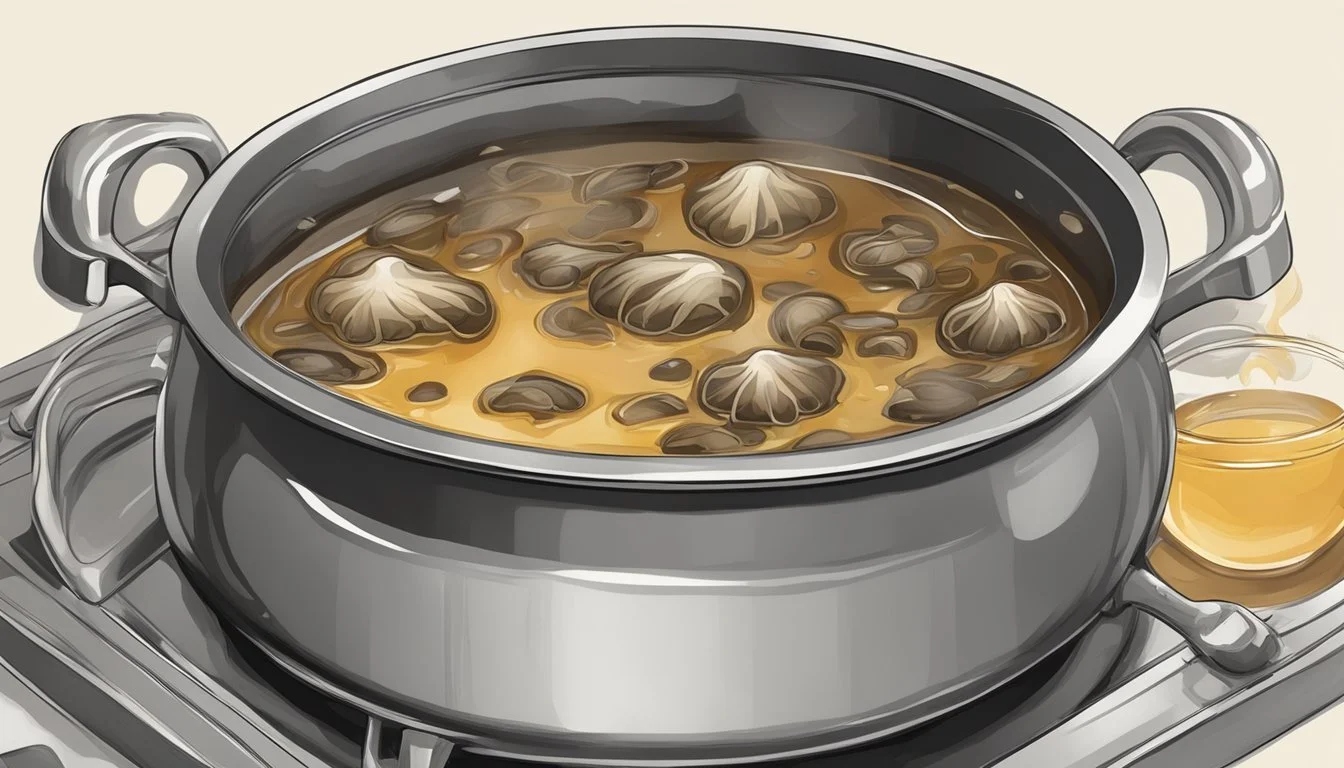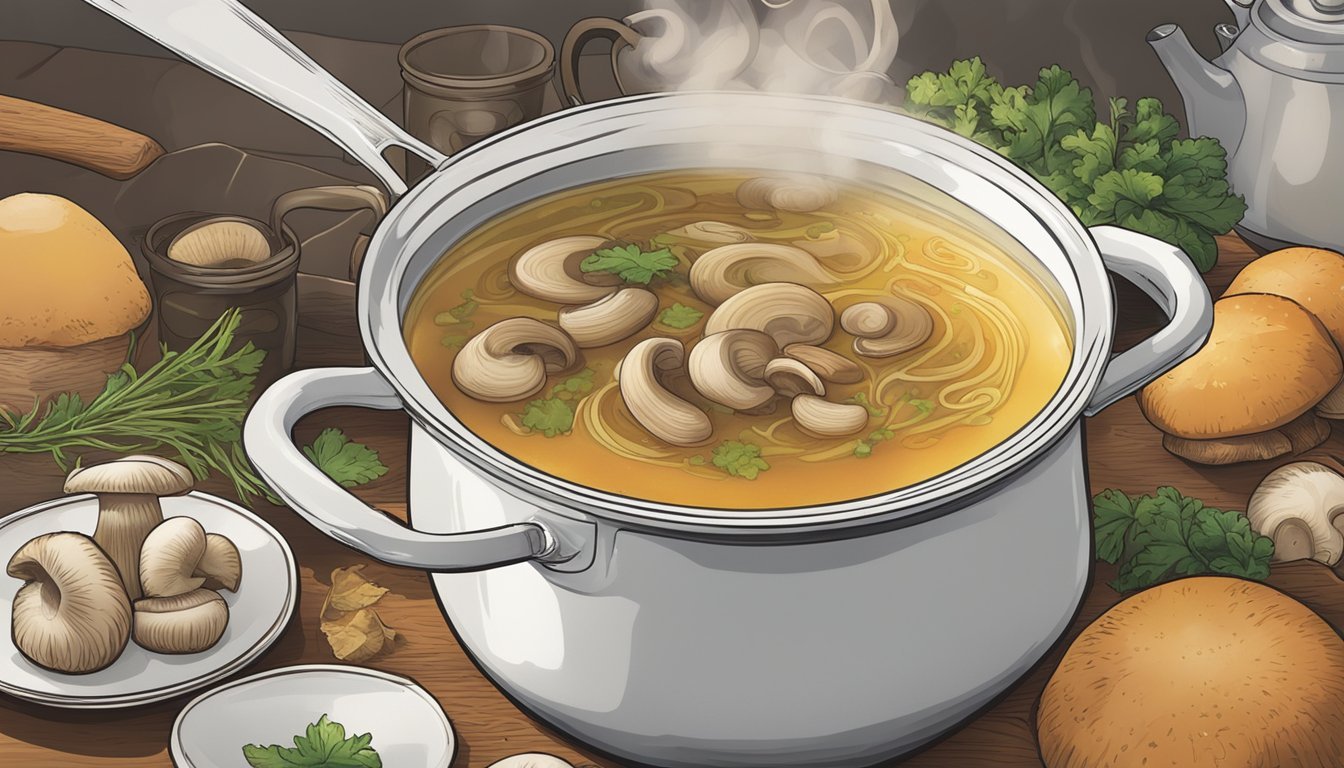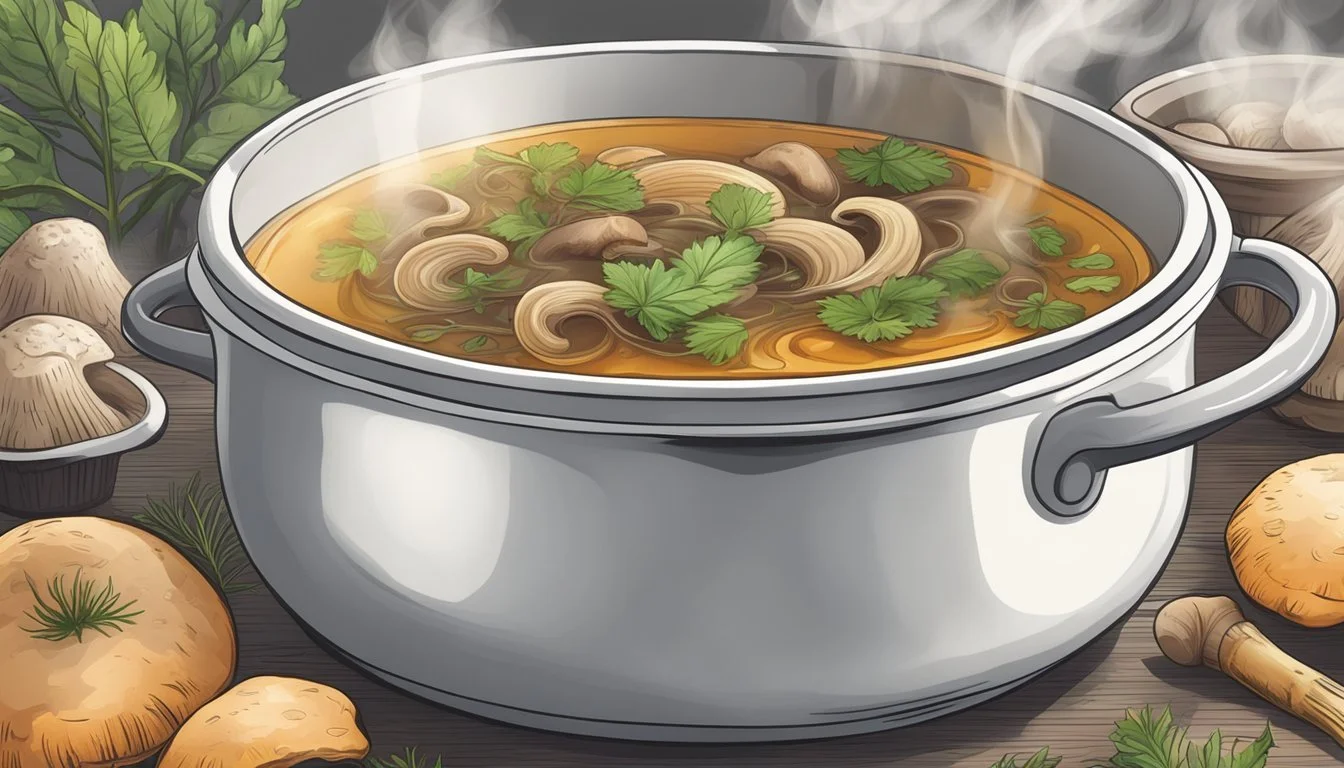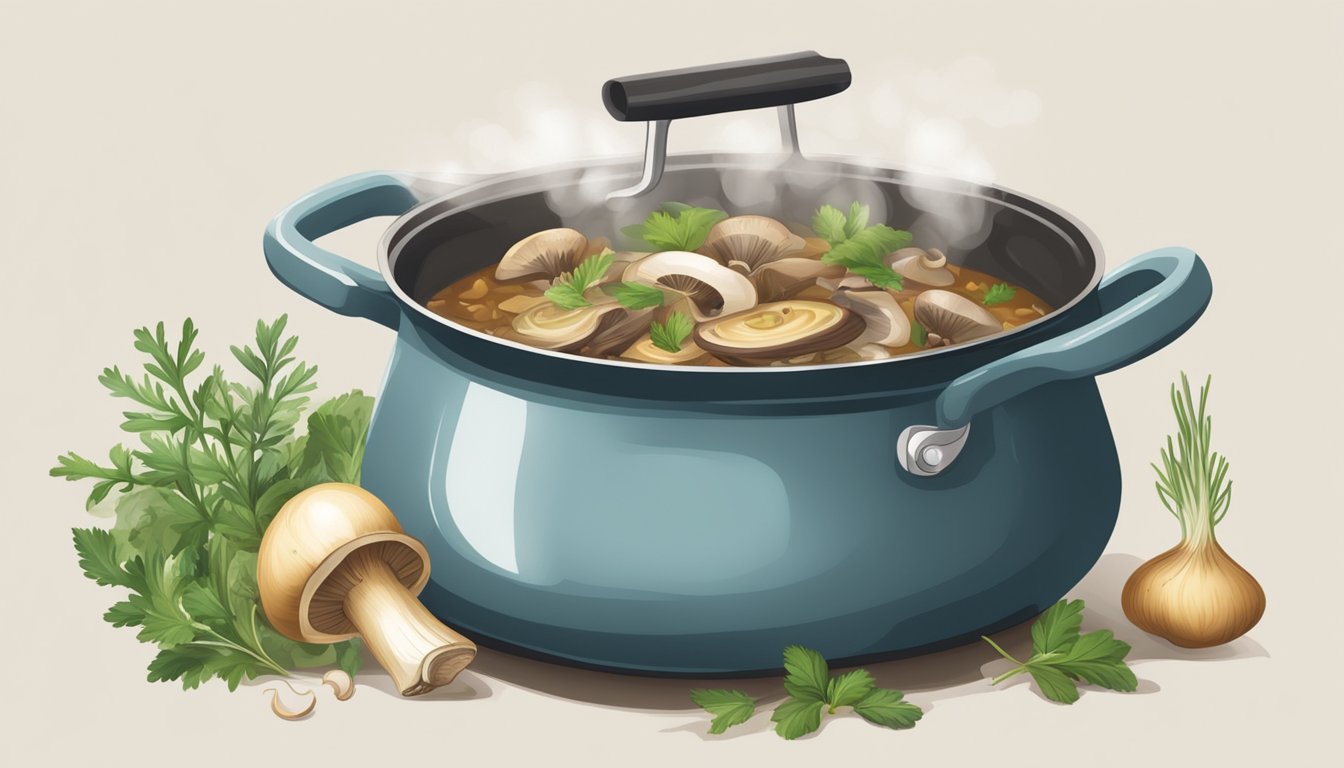Mushroom Stem Broth
A Rich, Umami-Packed Base for Flavorful Soups and Sauces
Mushroom stem broth emerges as a culinary trend for its deeply savory, nutrient-rich properties, making it a favored choice for chefs and home cooks alike. Delving into the essence of umami, this broth capitalizes on the often-discarded stems of mushrooms (What wine goes well with mushrooms?), transforming them into a robust and versatile base. With its earthy tones and complex flavor profile, mushroom stem broth serves not only as a foundation for soups and stews but also as a vegan substitute to enhance the taste of numerous dishes.
The creation of this broth involves simmering mushroom stems, which are usually by-products in the kitchen, with an assortment of aromatic vegetables and herbs. This process extracts the maximum flavor from the stems, resulting in a stock that is rich in minerals and umami, the so-called fifth taste that adds depth and fullness to the palate. By reusing stems that would otherwise be wast waste, this broth is also an exercise in resourceful cooking, adding both an economical and environmentally friendly approach to food preparation.
In the age where plant-based diets are gaining momentum, mushroom stem broth stands out as a sustainable and flavorful option. Its high umami content is especially appealing to those seeking to reduce their meat intake without compromising on taste. As a base, it's incredibly adaptive, lending itself well to a variety of cuisines and culinary applications. Whether it is used to cook grains, as a base for gravy, or as a warming beverage, mushroom stem broth is a testament to the ingenuity of maximizing flavors from simple ingredients.
Understanding Umami: The Fifth Taste
In culinary realms, umami takes its place as the sophisticated fifth taste, alongside sweet, bitter, sour, and salty. This taste is responsible for imparting a savory, brothy, rich or meaty taste to foods, fulfilling a role as an underlying flavor enhancer.
The Science of Umami
Umami is fundamentally linked to the amino acid called glutamic acid, which is found in many foods. When glutamic acid breaks down—whether through cooking, fermentation, or ripening—it transforms into glutamate. Glutamate is the substance that activates umami receptors on the human tongue and is instrumental in the perception of umami flavor. This response is part of a chemical reaction that occurs when proteins, which are composed of amino acids including glutamic acid, are broken down.
Key Elements in Umami Perception:
Glutamic Acid: An amino acid present in many foods.
Glutamate: The form glutamic acid takes after breaking down, which activates umami taste.
Sources of Umami in Food
Umami is prevalent in a diverse range of foods that are rich in glutamate and often in proteins. These umami-rich sources can be both animal-based and vegan-friendly. For non-vegan options, umami is notably present in meats, aged cheeses (What wine goes well with aged cheeses?), and seafood like anchovies. (What wine goes well with anchovies?) As for vegan sources, certain vegetables and fermented products are especially high in natural glutamate.
Examples of Umami-Rich Foods:
Animal-based Products: Meats, mature cheeses, and seafood.
Vegan Options: Tomatoes, mushrooms, soy sauce, and fermented foods. (What wine goes well with fermented foods?)
Mushroom stem broth stands out as an exceptional vegan umami base due to mushrooms' high levels of naturally occurring glutamic acid. When mushroom stems are simmered into a broth, they release glutamate and elevate the savory taste profile of the dish they're used in. The nutritious aspects of mushrooms further contribute to the overall protein content of the broth, making it not only a tasty but also a healthful component of cooking.
Key Ingredients for Mushroom Stem Broth
The construction of a rich mushroom stem broth is rooted in the careful selection of mushrooms and supporting ingredients. Each component works synergistically to create a profound depth of flavor that serves as the base for various culinary applications.
Mushroom Varieties and Their Flavors
Mushrooms are the backbone of this broth, offering earthy tones and a meaty texture.
Shiitake mushrooms: With their intense umami flavor, both fresh and dried shiitake mushrooms are essential. Dried shiitake, in particular, impart a stronger taste.
Other varieties: Incorporating other mushrooms like cremini or portobello can adjust the flavor profile, adding complexity to the broth.
Aromatic Support: Vegetables and Herbs
Vegetables and herbs serve to enhance the natural flavors of the mushrooms, adding brightness and layers to the broth.
Onions and garlic: These form the aromatic base, contributing sweetness and pungency.
Celery and carrots: These vegetables add a subtle bitterness and earthy notes that ground the broth.
Parsley: Fresh parsley provides a mild, herby backdrop.
A balance of these elements is critical for a well-rounded broth.
Umami-Rich Additions
For an additional umami boost, certain ingredients can be included to elevate the broth’s savoriness:
Kombu: This edible seaweed infuses the broth with a salty, oceanic essence.
Miso paste or soy sauce: Both are fermented products that bring saltiness and enhance the umami character.
Nutritional yeast: Often added for a cheese-like flavor that complements the other umami components.
Their inclusion is optional but recommended for a more profound flavor profile.
The Art of Broth Making
Making a rich and flavorful mushroom stem broth is an art that combines simple ingredients and precise techniques. This section provides essential guidance for preparing the mushrooms, mastering simmering techniques, and effectively straining and storing the broth for both vegetarian and vegan use.
Preparing the Mushrooms
The initial step in crafting a delightful mushroom stem broth is the preparation of the mushrooms. Begin by thoroughly cleaning the mushrooms to remove any dirt. He or she then needs to separate the stems from the caps, as the stems hold a concentrated amount of umami flavor, which is essential for a deep and savory broth. For additional richness, the baker can roast the stems on a rimmed baking sheet in the oven, enhancing their natural flavors before they are submerged in water.
Simmering Techniques
Once the mushrooms are prepared, the person moves to the simmering process. They should add the prepared mushroom stems to a pot of water and bring the mixture to a boil. Then, reduce the heat to achieve a gentle simmer. This part is crucial; a steady simmer allows the flavors to meld together without boiling away the nuanced tastes. The chef should allow the broth to reduce by at least one quarter, ensuring that it is rich and concentrated in flavor.
Straining and Storing the Broth
After simmering, comes the clarification step. The cook should carefully pour the broth through a fine-mesh sieve to separate the liquid from the solids. At this point, one can press the mushroom stems to extract as much liquid and flavor as possible. Subsequently, the clear broth can be stored in the refrigerator for immediate use, or frozen in airtight containers for future culinary endeavors. A well-strained broth forms a versatile base for an array of dishes and is a cornerstone of vegetarian and vegan cooking.
Mushroom Stem Broth Recipes and Uses
Mushroom stem broth offers a deep umami flavor ideal for vegetarian soups and provides a versatile base for a myriad of culinary applications. Its hearty essence enriches recipes, transforming dishes with complexity and depth.
Classic Mushroom Stem Soup
The foundation of a Classic Mushroom Stem Soup begins with a robust broth made from simmering mushroom stems. The process typically involves sautéing aromatic vegetables such as onions, garlic, and carrots to create a fragrant base. Mushroom stems are then added to the mix and sautéed until softened, enhancing the broth’s flavor.
For a simple yet satisfying soup, one can add coarsely chopped shiitake and cremini mushroom caps, along with a bouquet of herbs like thyme and bay leaves. The components are enveloped in the mushroom stem broth and simmered until the vegetables are tender. This soup serves as an excellent starter to a meal or can be enjoyed as a light, standalone dish.
Creative Culinary Applications
Mushroom stem broth is not limited to soups; it can be the secret ingredient in stews, braises, and other culinary explorations. Due to the concentration of flavors within the broth, it can serve as a liquid component to deglaze pans, imparting richness to sauces or gravies. One might also use it as a cooking medium for grains like rice or barley, where it infuses its umami profile into the dish.
In the realm of creative culinary applications, chefs may utilize mushroom stem broth in vegetarian versions of traditional dishes such as risotto or pot pie, substituting it for animal broths. The broth can also be reduced to intensify its taste, serving as a drizzling sauce over protein alternatives like tofu or tempeh. This versatility showcases the potential of mushroom stems, often discarded, as a valuable ingredient with multifaceted uses in the kitchen.
Complementary Flavors and Pairings
When crafting a meal with mushroom stem broth as the base, it's essential to consider how different flavor profiles will complement the deep umami character of the broth. The right pairing can enhance the broth's richness while adding complexity to the dish.
Balancing Taste Profiles
Mushroom stem broth's savory umami quality pairs well with a range of flavors that can either balance or enhance its taste. Sweet flavors can offset the inherent savory richness of the broth, while sour notes can add a refreshing zing that cleanses the palate. Bitterness, often contributed by certain vegetables or charred ingredients, can provide depth, and a touch of saltiness, achieved through the careful addition of sodium, enhances the broth's natural flavor.
Sweet: Incorporate sweetness by adding roasted root vegetables or a drizzle of sugar in a caramelized form.
Sour: Introduce a sour element with a splash of vinegar or tomatoes, which can brighten the flavor profile.
Salty: Balance saltiness with ingredients naturally high in salt or by adding a controlled amount of sea salt or soy sauce.
Bitter: Bitter vegetables like kale or roasted brussels sprouts add a contrasting note that complements the broth's richness.
Suggested Flavor Enhancers
While the umami-rich base of mushroom stem broth is flavorful on its own, certain ingredients can be added to enhance or complement its existing flavor profile. These can act as a bridge between the broth and the accompanying dish, such as rice, which readily absorbs and integrates these flavors.
Sweetness Enhancers:
Carrots
Sweet peas
Sweet corn
Fat: Introduce richness with a drizzle of high-quality oil like olive oil or by stirring in a pat of butter.
Sour Enhancers:
Lemon juice
Tamarind paste
Salty Enhancers:
Soy sauce
Anchovy paste
Parmesan rinds
Bitterness Enhancers:
Roasted garlic
Charred onions
Pairing the broth with these flavor enhancers not only builds on its character but also allows it to stand out as the star of a dish, whether it's a simple soup or a complex stew.
Maximizing Nutritional Benefits
When crafting a mushroom stem broth, one can significantly enhance the nutritional intake by understanding the inherent value found in mushrooms and applying healthy cooking practices.
Nutritional Profile of Mushrooms
Mushrooms are a powerhouse of nutrition, containing a variety of vitamins, minerals, and antioxidants. They offer a source of complete protein, essential for vegetarians and vegans. Specifically, shiitake, lion's mane, and reishi varieties are notable for their health-supporting properties.
Vitamins and Minerals: B vitamins, Vitamin D, potassium, selenium
Antioxidants: Ergothioneine, glutathione
Protein: Higher amounts in shiitake and lion's mane, including all nine essential amino acids
These components contribute to overall wellbeing, including nerve health, immune system support, and potential benefits for skin and hair.
Healthy Cooking Practices
To retain the nutritional benefits of a mushroom stem broth, the cooking method is paramount. Utilizing healthy oils such as olive oil or sesame oil can enhance the flavor of the broth while adding beneficial fats. These oils have a higher smoke point which is ideal for sautéing mushrooms to a golden-brown perfection before simmering.
Sautéing:
Use a light amount of olive oil or sesame oil for their health-promoting fats.
Heat the oil over medium heat and add the stems until browned to enrich flavor.
Simmering:
Gentle simmering ensures nutrients are not destroyed by high heat.
Cover while cooking to prevent nutrient loss through vapor.
In conclusion, mushroom stem broth can be a nutrient-dense component of a well-rounded vegetarian or vegan diet. By focusing on the nutritional profile of mushrooms and applying healthy cooking practices, one can maximize the potential health benefits offered by this umami-rich liquid.
Advanced Techniques for Umami
Perfecting umami in mushroom stem broth hinges on enhancing savory flavors through caramelization and integrating fermented ingredients rich in glutamate.
Caramelizing for Depth and Complexity
Caramelization is a pivotal technique that elevates the natural sugars in ingredients, imparting a deep, complex flavor profile accentuating the broth’s umami essence. The process involves browning ingredients such as onions at a low to medium heat until they release their intrinsic sweetness, which complements the savory flavors inherent in mushroom stems. It is paramount to exercise patience and attentiveness:
Heat: Low to medium
Timeframe: Until a rich, golden-brown hue is achieved
Incorporating Fermented Elements
Fermented soybean products like miso and tamari are treasure troves of umami due to their high glutamate content. Use these elements judiciously to infuse the broth with a profound umami character without overshadowing the delicate mushroom flavors. Here's how to integrate them into your broth:
Miso: Dissolve into a small portion of the broth before mixing into the larger batch to ensure even distribution.
Tamari: Add in lieu of salt, enhancing the broth’s umami while seasoning it.
Moreover, incorporating other fermented foods such as kimchi can introduce complex layers of flavor. If using kimchi, finely chop and add it towards the end of the cooking process to preserve its vibrant notes.
Special Considerations for Dietary Restrictions
When crafting a mushroom stem broth, it's important to consider dietary restrictions to ensure the broth is inclusive to vegan consumers and those with common food allergies or intolerances.
Creating a Vegan Umami Broth
A vegan umami broth relies on plant-based sources to achieve its distinctive, savory flavor. Traditional umami flavor often comes from meat or seafood, but for a vegan variant, one can focus on using the stems of mushrooms, which are rich in glutamates, to impart a meaty taste. To enhance the umami quality of the broth without animal products, one might add ingredients like:
Sun-dried tomatoes
Seaweed, such as kombu
Fermented condiments like soy sauce or tamari (gluten-free)
These ingredients contribute depth and complexity to the vegan umami broth.
Adapting Recipes for Allergies and Intolerances
When adapting mushroom stem broth for individuals with allergies or intolerances, identify common allergens including wheat (in soy sauce), nuts, and other specific dietary restrictions. For a gluten-free version of the broth, tamari can replace traditional soy sauce. It's critical to scrutinize every ingredient, ensuring it complies with the dietary needs of those who will consume the broth. Here’s a simplified guide:
Allergy-Friendly Substitutes:
Common Allergen Substitute Soy Coconut aminos or liquid aminos Seaweed Mushroom powder for savory depth Nutritional Yeast Omit or use a yeast-free seasoning mix
Crafting a mushroom stem broth with special dietary considerations in mind allows for a rich, flavorful base that everyone can enjoy, regardless of their dietary restrictions.
Tips and Tricks for the Home Cook
Crafting a rich, umami-packed mushroom stem broth is all about maximizing flavors and smart preservation. The home cook can transform kitchen scraps into a culinary base that enhances a variety of dishes, from soups to risottos.
Reusing Mushroom Stems
Mushroom stems are often discarded, yet they're a treasure trove of taste. Here's how to make the most of them:
Save the Stems: Collect and store mushroom stems in the freezer until you have enough to make broth.
Roasting Vegetables: For a deeper flavor, roast carrots, onions, and mushroom stems together before adding them to the pot.
Sautéing: Begin by sautéing the stems to unlock their earthy umami flavors before simmering.
Infusing Flavors: Enhance the broth by adding aromatic ingredients like ginger and scallions during the simmering process.
The cook time is critical when simmering these ingredients to coax out their full potential. A simmer of at least 30 minutes is recommended, although longer simmering will intensify the flavors.
Storing and Preserving Flavors
Once the broth is crafted, preserving its freshness is key:
Cooling Down: Ensure the broth is properly cooled before storing to maintain its quality.
Refrigeration: Store in airtight containers in the refrigerator for up to a week.
Freezing: Pour the cooled broth into freezer-safe containers, leaving some room for expansion. It can be stored in the freezer for several months.
Incorporating white miso paste at the end of the cooking process can add depth and complexity to the mushroom broth. However, to maintain the delicate flavors, do not boil the broth after adding miso; instead, whisk it in off the heat.
Global Inspirations: Mushroom Broth in World Cuisines
When exploring the role of mushroom broth in cuisines around the globe, one sees its versatility and importance as a flavor enhancer. Japanese recipes frequently utilize this rich, umami-packed broth, often incorporating ingredients like miso and soy sauce that complement its depth. Mushroom broth can serve as a base for miso soup, adding layers of savory taste to the traditional blend of miso paste, seaweed, and tofu.
The Korean kitchen takes advantage of mushroom broth's richness as well, incorporating it into dishes that might feature the bold flavors of kimchi or a splash of rice vinegar. The broth's subtle taste balances the fermented tang of kimchi, creating a harmonious blend in stews and hot pots.
Examples in Asian Cuisines:
Japanese:
Often found in ramen and noodle soups.
Serves as a base for cooking rice, enhancing the dish with an earthy flavor.
Korean:
Used in jjigae (stew) with kimchi for a complex taste profile.
In addition to these uses, mushroom broth can contribute to the delicacy of sauces and braises in various global cuisines. Aiding in the infusion of delicate flavors without overpowering them, chefs worldwide appreciate its ability to bind different components into a cohesive dish.
Western Applications:
As a vegetarian substitute for beef or chicken stock in risottos, gravies, and soups.
Paired with herbs like thyme and rosemary to elevate vegetable stews.
Pairing mushroom broth with green tea can offer a refreshing and aromatic twist on both ingredients' earthy qualities, signaling the innovative directions chefs are taking with this versatile broth in contemporary culinary applications.






